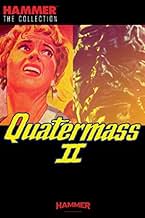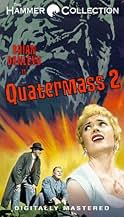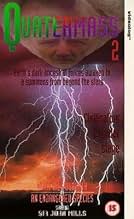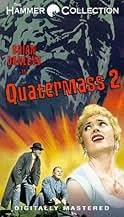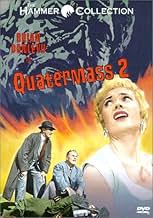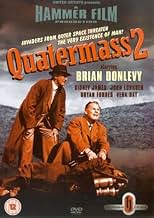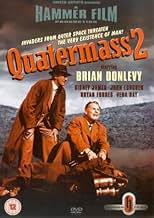IMDb रेटिंग
6.7/10
5.1 हज़ार
आपकी रेटिंग
प्रोफेसर क्वाटरमास, अपने चंद्र उपनिवेशीकरण परियोजना के लिए समर्थन इकट्ठा करने की कोशिश कर रहे हैं, जो रहस्यमय निशान से चिंतित हैं जो दिखाई दे रहे हैं।प्रोफेसर क्वाटरमास, अपने चंद्र उपनिवेशीकरण परियोजना के लिए समर्थन इकट्ठा करने की कोशिश कर रहे हैं, जो रहस्यमय निशान से चिंतित हैं जो दिखाई दे रहे हैं।प्रोफेसर क्वाटरमास, अपने चंद्र उपनिवेशीकरण परियोजना के लिए समर्थन इकट्ठा करने की कोशिश कर रहे हैं, जो रहस्यमय निशान से चिंतित हैं जो दिखाई दे रहे हैं।
John Longden
- Lomax
- (as John Longdon)
Sidney James
- Jimmy Hall
- (as Sydney James)
फ़ीचर्ड समीक्षाएं
The second of the Quatermass films (the first was THE QUATERMASS XPERIMENT, the "X" used to emphasise the adult X-rating the film received on its initial release) was allowed a slightly larger budget and benefited enormously from Nigel Kneale's participation in the screenplay. In this film, at least Brian Donlevy behaves a little more like Quatermass ought to, though I still don't think he was right for the part.
For my money, Quatermass should be a pipe-smoking English boffin with leather patches sewn on the elbows of his jacket. The original character was conceived as a kind of Barnes Wallis type, as portrayed by Michael Redgrave in THE DAM BUSTERS.
The movie is set in a post-war Britain that was a little panicked by the idea of nuclear weapons and even more unsettled by the knowledge that our former allies, The Soviets, had the same weapons and they were pointed at us. This was the climate that gave us Orwell's 1984 and Don Siegel's INVASION OF THE BODY SNATCHERS. Paranoia was out to get us ...
This same atmosphere lasted well into the 1960s and can also be glimpsed in TV shows like THE AVENGERS. This was the era I grew up in, so I speak from personal experience :-)
This movie is one of Hammer's better offerings of the period. Released the same year as CURSE OF FRANKENSTEIN, it more than holds its own against the other, better-known Hammer colour offerings. Indeed, it benefits from its monochrome photography, which brilliantly communicates the austerity of the years immediately following WWII.
Thoroughly recommended, this film will appeal to anyone who can get beyond the admittedly primitive 1950s special effects to be rewarded by the rich and clever story that lies beneath the slightly dodgy veneer ...
For my money, Quatermass should be a pipe-smoking English boffin with leather patches sewn on the elbows of his jacket. The original character was conceived as a kind of Barnes Wallis type, as portrayed by Michael Redgrave in THE DAM BUSTERS.
The movie is set in a post-war Britain that was a little panicked by the idea of nuclear weapons and even more unsettled by the knowledge that our former allies, The Soviets, had the same weapons and they were pointed at us. This was the climate that gave us Orwell's 1984 and Don Siegel's INVASION OF THE BODY SNATCHERS. Paranoia was out to get us ...
This same atmosphere lasted well into the 1960s and can also be glimpsed in TV shows like THE AVENGERS. This was the era I grew up in, so I speak from personal experience :-)
This movie is one of Hammer's better offerings of the period. Released the same year as CURSE OF FRANKENSTEIN, it more than holds its own against the other, better-known Hammer colour offerings. Indeed, it benefits from its monochrome photography, which brilliantly communicates the austerity of the years immediately following WWII.
Thoroughly recommended, this film will appeal to anyone who can get beyond the admittedly primitive 1950s special effects to be rewarded by the rich and clever story that lies beneath the slightly dodgy veneer ...
Val Guest's Quatermass II is my favourite film ever. The cold, dawning revelation that builds up all the way through the first half of the film that the invasion is actually underway and that the 'zombies' not only WALK AMONG US, but are actually IN CHARGE and IN POWER is terrifyingly atmospheric. I always like to think that if the invasion ever did come, it wouldn't come through massive mother ships as per Independence Day, but from within, from the suburbs, the rural villages. Really clever invaders would use Earth's own power structures, governments and resources against it without anyone noticing, not turn up en masse in flying saucers spoiling for a fight. The idea of the invasion falling to Earth in meteorites through a form of collective intelligence (recycled in the 1973 BBC Doctor Who serial Spearhead From Space) continues this threatening vein of invasion, and provides the most atmospheric scene in the film when Quatermass stands in the open night air as whizzing sounds around him give away the increased number of the meteorites now falling (the invasion is now fully underway!). Other scenes are just downright terrifying and follow the Kneale tradition of 'terror through revelation': the lorries in London carrying the symbol; Quatermass' first glimpse through the dome viewing panel; and when it is revealed how the zombies are blocking the pipes!! This 'revelation' aspect can be seen in all of the Quatermass films and serials (in The Quatermass Conclusion: when it is revealed by the body parts that the hippies weren't 'transported', in Quatermass and the Pit: 'you mean WE are the Martians!!'). Storytelling, atmosphere and terror like this hasn't survived the onset of today's special effects. Film makers like Dean Devlin just don't need to employ methods like this anymore, and this is why thinking people's science fiction relying on chilling, atmospheric and scientifically valid stories, plots and concepts will never ever be repeated.
'Quatermass 2' is even better than the excellent 'The Quatermass Xperiment'. Like the first movie it was a remake of the original British TV production which I have sadly not seen (both are lost I think). Val Guest directs once again, Brian Donlevy reprises the role of the crusty Professor Quatermass, and this time Nigel Kneale was allowed to adapt his own original script, which probably explains why it improves on the first movie. Quatermass stumbles across a mysterious secret Government installation which is supposedly developing synthetic food, but is in fact something quite different and frightening. Donlevy isn't my favourite Quatermass but he is better here than in the first movie, and the supporting cast includes John Longden in the role originally played by Jack Warner, Bryan Forbes as Quatermass' assistant Marsh (another change of actor), comedian Sid James of 'Carry On' fame, and Hammer regular Michael Ripper. 'Quatermass 2' is a very entertaining and suspenseful thriller, which hasn't dated as half as much as you'd expect. It will particularly be interesting to fans of 'Invasion Of The Body Snatchers', which it shares certain themes with, and 'The X-Files', which many people, myself included, would argue owes this movie and the next in the series 'Quatermass and the Pit' a large debt. Nigel Kneale is one of the most underrated writers of SF and horror of our time (over 80 years old and still active!), and the Quatermass movies are his best known and enjoyable achievements. I highly recommend them all.
Thanks to a good friend I'm currently undergoing what sci-fi fans refer to as "the Quatermass-experience". That simply means watching the three QUATERMASS-movies in a short time period. The first one felt like a true sci-fi classic, but I honestly couldn't really tell, because I haven't seen enough of those black & white sci-fi flicks to compare it too. But I'm working on that.
After having seen QUATERMASS 2, I'm starting to get convinced that those movies really are a stellar trilogy (even though the individual stories aren't actually related). This second installment was the first British movie ever to feature a number "2" in its title, to indicate that it's a sequel. The movie itself shows a lot of similarities with the original INVASION OF THE BODY SNATCHERS (an alien organism invading earth, loss of human identity, a common higher consciousness, a global threat at hand...). But since they were produced around the same time none of the movies can be accused of stealing from each other.
Writer Nigel Kneale presents us a solid, coherent story undermined with plausible scientific facts. To put it rather simply: an organism not of this earth infects humans and even infiltrates the highest ranks of the British government. The story moves at a decent pace and never gets boring. Val Guest's directing is as good as it gets for a movie from the 50's. He clearly knew what he was doing on the set. Some minor continuity problems can be encountered (some night shots feature a few glimpses of daylight) and at least one scene seemed a bit artificially staged for convenience's sake (the one where Broadhead and Quatermass get their passes from the ministry-chap). But all that really isn't anything to complain about.
I sort of liked Brian Donlevy as Quatermass. He really feels like the prototype of an anti-hero. He's often a bit rude and really persistent. Especially that last characteristic made his character more believable. The rest of the acting was also decent, though all of the supporting roles were too small to be memorable. And I so much liked the fact that there wasn't an obligatory love-interest in the plot for Mr. Quatermass. That simply would not have worked.
There were a few details I really liked, like when Quatermass arrives in that little town in the area of Winterton Flats (or was it Willingdon Flats?). All the inhabitants work for the alien-infested factory and they have posters on the wall with slogans like "Remember: Secrets mean sealed lips" and "Talk about your job. Lose it". Another cool thing about the story was that it was actually Quatermass who designed the factory facility with the domes, which was originally to be a moon-colonization project. Only, the government stole his design and build it here on earth, for the alien organism to adapt itself. The factory was an excellent location and felt real. So were the few special effects (mainly miniatures of the domes). The 'rocket-lift-off' shots and effects looked rather silly though. I'm glad this movie was in black & white, that way, when we finally see the alien organism in all its giant glory, it looked a bit more terrifying.
So if you're curious about the history of sci-fi movies, than you just can not miss this one. Now I'm really looking forward to see QUATERMASS AND THE PIT.
After having seen QUATERMASS 2, I'm starting to get convinced that those movies really are a stellar trilogy (even though the individual stories aren't actually related). This second installment was the first British movie ever to feature a number "2" in its title, to indicate that it's a sequel. The movie itself shows a lot of similarities with the original INVASION OF THE BODY SNATCHERS (an alien organism invading earth, loss of human identity, a common higher consciousness, a global threat at hand...). But since they were produced around the same time none of the movies can be accused of stealing from each other.
Writer Nigel Kneale presents us a solid, coherent story undermined with plausible scientific facts. To put it rather simply: an organism not of this earth infects humans and even infiltrates the highest ranks of the British government. The story moves at a decent pace and never gets boring. Val Guest's directing is as good as it gets for a movie from the 50's. He clearly knew what he was doing on the set. Some minor continuity problems can be encountered (some night shots feature a few glimpses of daylight) and at least one scene seemed a bit artificially staged for convenience's sake (the one where Broadhead and Quatermass get their passes from the ministry-chap). But all that really isn't anything to complain about.
I sort of liked Brian Donlevy as Quatermass. He really feels like the prototype of an anti-hero. He's often a bit rude and really persistent. Especially that last characteristic made his character more believable. The rest of the acting was also decent, though all of the supporting roles were too small to be memorable. And I so much liked the fact that there wasn't an obligatory love-interest in the plot for Mr. Quatermass. That simply would not have worked.
There were a few details I really liked, like when Quatermass arrives in that little town in the area of Winterton Flats (or was it Willingdon Flats?). All the inhabitants work for the alien-infested factory and they have posters on the wall with slogans like "Remember: Secrets mean sealed lips" and "Talk about your job. Lose it". Another cool thing about the story was that it was actually Quatermass who designed the factory facility with the domes, which was originally to be a moon-colonization project. Only, the government stole his design and build it here on earth, for the alien organism to adapt itself. The factory was an excellent location and felt real. So were the few special effects (mainly miniatures of the domes). The 'rocket-lift-off' shots and effects looked rather silly though. I'm glad this movie was in black & white, that way, when we finally see the alien organism in all its giant glory, it looked a bit more terrifying.
So if you're curious about the history of sci-fi movies, than you just can not miss this one. Now I'm really looking forward to see QUATERMASS AND THE PIT.
This film was actually the first sequel to use a number in the title (although it's American title was "Enemy from Space"). Not only was this a cleverly written film, based on Nigel Kneale's screenplay, but it was a cruel satire on English and American culture in the 1950s.
In a nutshell, Professor Bernard Quatermass, leader of England's rocket group, is at wit's end trying to get more funding for his projected moon project. The British government decides it has "projects of far greater importance.'' At the same time, workers at Quatermass' base detect scores of what look like meteorites falling close by. When Quatermass investigates, he not only finds remnants of the meteorites, but his moon base, conveniently appropriated by an unknown government entity. His lab assistant picks up one of the meteorites and it explodes in his face, immediately infecting him with an alien parasite.
Quatermass is forced to go it almost alone, helped by a cynical police inspector, a drunken beat reporter and a vigilant member of parliament who can't get even his own party members to question where millions of pounds of tax dollars are going to.
The cruel satire comes from the comparison of Western governments of the 1950s to the communist governments they vehemently opposed during the Cold War years. British citizens were taught to implicitly trust government even as it spent millions to unknowingly fund an alien invasion. Civilian workers were so glad to have jobs they don't question why the supposed "synthetic food" plant they're building needs huge doses of toxic gases like ammonia. Even when evidence of wrongdoing is brought up, government red tape squelches it.
As for the movie itself, it is much better written than the original ("The Quatermass Experiment"). Nigel Kneale softens Quatermass' dour and brusk personality. Director Val Guest effectively uses a string musical score to build a creepy atmosphere. He and Kneale even overcome the first movie's dull ending, which had an alien getting electrocuted with no suspense whatsoever. Here, the plant workers, angry that one of their own is carted away by infected security guards at gunpoint, try to storm the plant, turning the aliens' carefully planned invasion on its ear. The irony, of course, is that the plant was conceived because government bureaucracy kept it secret. Now, as the plant is threatened, the same secrecy prevents the aliens from calling for help from the police or armed forces.
The special effects are better in this film, though the giant aliens at the end are not as convincing as they could be. Still, the film is a great example of British science fiction, which relied more on plot and characterization than the special effects that dominated American science fiction.
In a nutshell, Professor Bernard Quatermass, leader of England's rocket group, is at wit's end trying to get more funding for his projected moon project. The British government decides it has "projects of far greater importance.'' At the same time, workers at Quatermass' base detect scores of what look like meteorites falling close by. When Quatermass investigates, he not only finds remnants of the meteorites, but his moon base, conveniently appropriated by an unknown government entity. His lab assistant picks up one of the meteorites and it explodes in his face, immediately infecting him with an alien parasite.
Quatermass is forced to go it almost alone, helped by a cynical police inspector, a drunken beat reporter and a vigilant member of parliament who can't get even his own party members to question where millions of pounds of tax dollars are going to.
The cruel satire comes from the comparison of Western governments of the 1950s to the communist governments they vehemently opposed during the Cold War years. British citizens were taught to implicitly trust government even as it spent millions to unknowingly fund an alien invasion. Civilian workers were so glad to have jobs they don't question why the supposed "synthetic food" plant they're building needs huge doses of toxic gases like ammonia. Even when evidence of wrongdoing is brought up, government red tape squelches it.
As for the movie itself, it is much better written than the original ("The Quatermass Experiment"). Nigel Kneale softens Quatermass' dour and brusk personality. Director Val Guest effectively uses a string musical score to build a creepy atmosphere. He and Kneale even overcome the first movie's dull ending, which had an alien getting electrocuted with no suspense whatsoever. Here, the plant workers, angry that one of their own is carted away by infected security guards at gunpoint, try to storm the plant, turning the aliens' carefully planned invasion on its ear. The irony, of course, is that the plant was conceived because government bureaucracy kept it secret. Now, as the plant is threatened, the same secrecy prevents the aliens from calling for help from the police or armed forces.
The special effects are better in this film, though the giant aliens at the end are not as convincing as they could be. Still, the film is a great example of British science fiction, which relied more on plot and characterization than the special effects that dominated American science fiction.
क्या आपको पता है
- ट्रिवियाThis is believed to be the first film ever to use the arabic numeral 2 as an indicator that it was the sequel to another film (as opposed to Roman numerals).
- गूफ़When hurrying to the phone in the Pressure Control Block, McLeod puts down his jacket, which slips to the floor. It appears to have returned to where he originally placed it when he retrieves it in another shot, however.
- भाव
Quatermass: They tell me you have no police here?
Dawson: Police? We don't need them - we're a law-abiding community, aren't we?
- कनेक्शनFeatured in The Saturday Afternoon Movie: Enemy From Space (1966)
टॉप पसंद
रेटिंग देने के लिए साइन-इन करें और वैयक्तिकृत सुझावों के लिए वॉचलिस्ट करें
- How long is Quatermass 2?Alexa द्वारा संचालित
विवरण
बॉक्स ऑफ़िस
- बजट
- £92,000(अनुमानित)
- चलने की अवधि1 घंटा 25 मिनट
- रंग
इस पेज में योगदान दें
किसी बदलाव का सुझाव दें या अनुपलब्ध कॉन्टेंट जोड़ें



